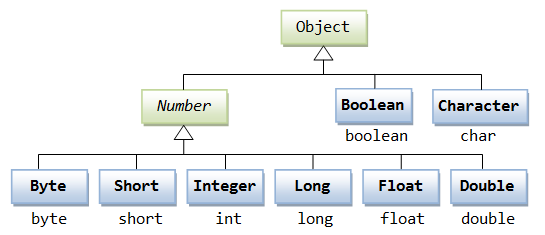对象包装器、自动装箱与拆箱 2016/11/30 晚
特点

1.所有的基本类型都有一个包装器类与之对应。[Integer,Boolean,Long,Character,Short,Float,Double,Void,Byte]
public abstract class Number implements java.io.Serializable {
public final class Float extends Number implements Comparable<Float> {
2.对象包装器类是final的,意味着:
①不能定义他们的子类。
②一旦构造了包装器,就不允许修改包装在其中的值.//如何理解其深意?内部不可变,外部装拆
Eg1. public static void triple(Integer x){ //won't work
。。。
} //Integer x做形参,在函数体内是无法修改其值的。
Eg2. public static void triple(int x){ //will work
x = x+1;
} //对应的基本类型int x做形参,在函数体内是无法修改其值的。
3.利用包装器的类特性为基本类型使用泛型。泛型<>的尖括号内的类型参数,不允许是基本类型。【泛型只允许类类型】
Eg.我们要定义一个整型数组列表。而尖括号内的参数是不允许是基本类型,
即:不允许写成ArrayList<int>. 解决办法:ArrayList<Integer>
原理:
1.装箱:把基本类型用它们相应的引用类型包装起来,使其具有类对象的性质。
Eg.Integer x = 100;
自动装箱[声明并创建int x,将x的值放入Integer类中] (编译器调用的是static Integer valueOf(int i))
2.拆箱:和装箱相反,将引用类型的对象简化成值类型的数据。
Eg.int y = new Integer(100); 自动拆箱
Eg. Integer n=3;
n++; // [n拆箱;自增;n装箱] 注意与作形参的包装器区别。
==与.equals(Object obj)
==与.equals(Object obj):
A.java的==有两种作用:【用于比较对象的存储区域或比较基本类型的数值】
①用于比较两对象是否指向同一存储区域. 【比较对象的存储区域】
②用于比较两对象包装器对象:[具体分情况:]
a.比较两包装器的值:满足自动规范对象要求:int,short∈[-128,127];boolean,byte,char≤127 【比较基本类型】
b.不满足a条件时,执行①.
Eg3.Integer a = 1000;
Integer b = 1000;
(a == b) //result:fasle; 【比较对象的存储区域】
必须双方均为包装类对象,才以对象方式进行比较
Eg4.Integer a =100;
Integer b =100;
(a==b) //result:true; 【比较基本类型】
Eg5.Integer a = 100;
int b = 100;
(a==b) //result:true; 【比较基本类型】
Eg6.int a = 1000;
Integer b = 1000;
(a==b) //result:true; 【比较基本类型】一旦有一方为基本类型,就以基本类型数值比较 B..equals(Object obj)仅用于单纯地进行比较两对象的内容,而非存储区域!
综上,在比较两对象的内容时,建议使用equals()方法。
常用方法:
.equals()
.toString()
.praseX() //字符串与基本类型值的转化的常用方法
.compareTo()
.XValue()
.valueOf() //自动装箱时也会调用。
测试试题
public class Main{
public static void main(String []args){
String str1 = new String("hello");
String str2 = new String("hello");
System.out.println(str1==str2);
System.out.println(str1.equals(str2));//String equals已重写,比较内容
Integer int1 = 127;
Integer int2 = 127;
System.out.println(int1==int2);
System.out.println(int1.equals(int2));//Integer equals已重写,比较内容
Character ch1 = 128;
Character ch2 = 128;
System.out.println(ch1==ch2);
System.out.println(ch1.equals(ch2));//Character equals已重写,比较内容
A a1 = new A();
A a2 = new A();
System.out.println(a1.equals(a2));//equals未重写,比较内存地址
a2 = a1;
System.out.println(a1.equals(a2));//equals未重写,比较内存地址
}
}
class A extends Object{
public String a;
public void setA(){
this.a = a;
}
public String getA(){
return this.a;
}
}
//output
false
true
true
true
false
true
false
true
总结
1.定义:拆箱、装箱
2.二者效率:包装类的效率远远低于基本类型。因为:每new一个对象需要消耗更多内存,装箱操作会创建对象,频繁的装箱操作会消耗许多内存,影响性能,所以可以避免装箱的时候应该尽量避免。
3.==与equals(Obj)的区别
3.==与equals(Obj)的区别
1)对于==,如果作用于基本数据类型的变量,则直接比较其存储的 “值”是否相等;
如果作用于引用类型的变量,则比较的是所指向的对象的地址
2)对于equals方法,注意:equals方法不能作用于基本数据类型的变量
如果没有对equals方法进行重写,则比较的是引用类型的变量所指向的对象的地址;
诸如String、Date等类对equals方法进行了重写的话,比较的是所指向的对象的内容。
<引用出处:https://www.cnblogs.com/dolphin0520/p/3592500.html>
推荐文献
[2] 深入剖析Java中的装箱和拆箱